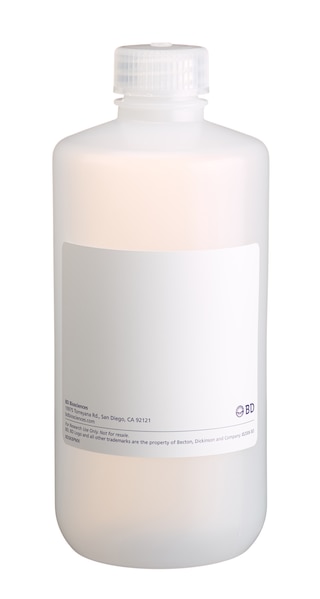Old Browser
This page has been recently translated and is available in French now.
Looks like you're visiting us from {countryName}.
Would you like to stay on the current country site or be switched to your country?


.png)

Flow cytometric analysis of CX3CL1 expression on HepG2 cells. Human HepG2 cells were stained with either APC Mouse Anti-Human CX3CL1 antibody (Cat. No. 567742/567743; solid line histogram) or APC Mouse IgG1 κ Isotype Control (Cat. No. 554681; dashed line histogram). DAPI (4',6-Diamidino-2-Phenylindole, Dihydrochloride) Solution (Cat. No. 564907) was added to cells right before analysis. Fluorescence histograms were derived from gated events with the forward and side light-scatter characteristics of viable (DAPI-negative) cells. Flow cytometry and data analysis were performed using a BD FACSymphony™ A5 Cell Analyzer System and FlowJo™ software.
.png)

BD Pharmingen™ APC Mouse Anti-Human CX3CL1 (Fractalkine)
.png)
Regulatory Status Legend
Any use of products other than the permitted use without the express written authorization of Becton, Dickinson and Company is strictly prohibited.
Preparation And Storage
Recommended Assay Procedures
BD® CompBeads can be used as surrogates to assess fluorescence spillover (Compensation). When fluorochrome conjugated antibodies are bound to BD® CompBeads, they have spectral properties very similar to cells. However, for some fluorochromes there can be small differences in spectral emissions compared to cells, resulting in spillover values that differ when compared to biological controls. It is strongly recommended that when using a reagent for the first time, users compare the spillover on cells and BD® CompBeads to ensure that BD® CompBeads are appropriate for your specific cellular application.
Product Notices
- This reagent has been pre-diluted for use at the recommended Volume per Test. We typically use 1 × 10^6 cells in a 100-µl experimental sample (a test).
- An isotype control should be used at the same concentration as the antibody of interest.
- Caution: Sodium azide yields highly toxic hydrazoic acid under acidic conditions. Dilute azide compounds in running water before discarding to avoid accumulation of potentially explosive deposits in plumbing.
- Please refer to www.bdbiosciences.com/us/s/resources for technical protocols.
- This APC-conjugated reagent can be used in any flow cytometer equipped with a dye, HeNe, or red diode laser.
- For fluorochrome spectra and suitable instrument settings, please refer to our Multicolor Flow Cytometry web page at www.bdbiosciences.com/colors.
- Please refer to http://regdocs.bd.com to access safety data sheets (SDS).
- Source of all serum proteins is from USDA inspected abattoirs located in the United States.
Companion Products


The V13-864 monoclonal antibody specifically recognizes CX3C motif chemokine Ligand 1 (CX3CL1), which is also known as fractalkine. CX3CL1 (Fractalkine) is the only known member of the CX3C chemokine subfamily and is expressed as both membrane-bound and secreted forms. Unlike other chemokines, CX3CL1is expressed on the surface of endothelial cells and not significantly expressed on peripheral blood leukocytes. CX3CL1's receptor is known as CX3CR1 and is expressed on cytotoxic T cells, NK cells, dendritic cells, and monocytes. Overexpression of CX3CL1 (Fractalkine) in some malignant tumors may contribute to the recruitment of effectors for innate and adaptive immunity.

Development References (5)
-
Bazan JF, Bacon KB, Hardiman G, et al. A new class of membrane-bound chemokine with a CX3C motif.. Nature. 1997; 385(6617):640-4. (Biology). View Reference
-
Colobran R, Pujol-Borrell R, Armengol MP, Juan M. The chemokine network. I. How the genomic organization of chemokines contains clues for deciphering their functional complexity.. Clin Exp Immunol. 2007; 148(2):208-17. (Biology). View Reference
-
Park MH, Lee JS, Yoon JH. High expression of CX3CL1 by tumor cells correlates with a good prognosis and increased tumor-infiltrating CD8+ T cells, natural killer cells, and dendritic cells in breast carcinoma. J Surg Oncol. 2012; 106(4):386-92. (Biology). View Reference
-
Zlotnik A, Yoshie O, Nomiyama H. The chemokine and chemokine receptor superfamilies and their molecular evolution.. Genome Biol. 2006; 7(12):243. (Biology). View Reference
-
Zlotnik A, Yoshie O. Chemokines: a new classification system and their role in immunity.. Immunity. 2000; 12(2):121-7. (Biology). View Reference
Please refer to Support Documents for Quality Certificates
Global - Refer to manufacturer's instructions for use and related User Manuals and Technical data sheets before using this products as described
Comparisons, where applicable, are made against older BD Technology, manual methods or are general performance claims. Comparisons are not made against non-BD technologies, unless otherwise noted.
For Research Use Only. Not for use in diagnostic or therapeutic procedures.
Report a Site Issue
This form is intended to help us improve our website experience. For other support, please visit our Contact Us page.